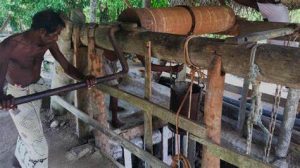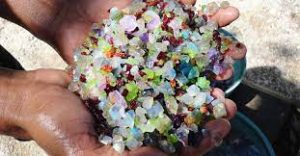Meetiyagoda Moonstone Mine
In the picturesque island of Sri Lanka, nestled in the Indian Ocean just off the southern coast of India, lies a treasure trove of the world’s finest moonstones. Sri Lanka’s gem deposits can be categorized into two main types: the more prevalent “sedimentary” deposits formed by the erosion and weathering processes of wind and water, and the less common primary deposits nestled within the bedrock itself.
One of the most renowned primary gem deposits in Sri Lanka is the vast pegmatite vein of moonstone located in Meetiyagoda, a charming village a short distance from the southwestern coastline of the island. This village proudly boasts ten mines, making it a significant source of top-quality blue moonstones since the precious gem’s discovery here in 1906.
Moonstone, a member of the feldspar family, is the most valuable among its kin. It is a sodium potassium aluminum silicate, distinguished by its unique composition. Moonstones consist of intricately intergrown layers of two distinct feldspar varieties, orthoclase and albite, each with differing refractive indices. The hallmark feature of moonstone is its ethereal billowy adularescence, often referred to as “schiller,” which results from the scattering of light by nanometer-sized particles within these layered formations. The most exquisite and rare moonstones exhibit a transparent colorless body adorned with a vibrant blue schiller.
The process of obtaining rough moonstones begins with shaft mining, known as “yati illama.” These shafts are narrow rectangular openings fortified with sturdy coconut wood beams that serve to reinforce the shaft walls. These horizontal beams are meticulously aligned at uniform heights, enabling the miners to gauge the depth of their descent.
To safeguard against water seepage, the miners employ kakilla leaves, a resilient variety of fern, behind the wooden beams. These leaves are capable of withstanding high pressure, ensuring the integrity of the mine structure. The wooden framework within the mine shaft is divided into two chambers: one facilitates the miners’ movement and the removal of the “illama” – the gem-bearing sludge – while the other accommodates an electric water pump employed to keep the lower sections of the mine dry.
 The water pumped from the mine is collected in a small reservoir for later use in washing the illama. The mine shaft extends approximately 20 meters through a layer of kaolin mud until it reaches the weathering surface of the pegmatite. It is here that miners commence the excavation of horizontal tunnels, referred to as “donava,” extending in four directions. Each tunnel spans around 10 meters in length and measures 2.5 meters in width, all lined with coconut wood beams.
The water pumped from the mine is collected in a small reservoir for later use in washing the illama. The mine shaft extends approximately 20 meters through a layer of kaolin mud until it reaches the weathering surface of the pegmatite. It is here that miners commence the excavation of horizontal tunnels, referred to as “donava,” extending in four directions. Each tunnel spans around 10 meters in length and measures 2.5 meters in width, all lined with coconut wood beams.
Upon completing the four initial tunnels, the miners proceed to deepen the main shaft by an additional 7.5 meters before embarking on the excavation of four more tunnels. This pattern continues until they reach either a maximum depth of 65 meters or the bedrock itself.
Each mine is staffed by a team of six miners, with three working on the surface and three descending underground. They rely on electric lamps to illuminate their work in the scorching heat, often reaching temperatures of 35 degrees Celsius.
The extraction of rough moonstones from the weathered vein occurs through the main shaft, employing a system known as “dabaraya.” This method utilizes a lengthy, heavy circular log placed across the mine shaft, manipulated by two miners in opposite directions using a ‘z’-shaped metal bar. Attached to this log is a pulley system that allows a bucket, suspended at one end of a rope, to be raised from the mine while lowering another bucket into it.
The freshly mined moonstones are collected in a specially designed shallow pit known as the “illam kamatha.” To safeguard against theft and prevent loss due to rain, this pit is covered with layers of kakilla fern leaves.
Once a week, typically on an auspicious day, the moonstones are meticulously washed in the reservoir, overseen by the mine owner. The cleaning process involves placing a few handfuls of gem-gravel into a shallow, circular wicker basket with a sturdy rim. This basket is then submerged in water and gently tilted and rotated until the stones are thoroughly cleaned.
Following the washing process, the rough moonstones are placed into buckets, ready to be transported to lapidaries for cutting and polishing. Lapidarists may employ a combination of modern and traditional cutting equipment, depending on their preferences and the specific requirements of the stones. While semi-automatic lapidary equipment is commonly used due to its efficiency and accuracy, the traditional “hanaporuwa” cutting machine, powered by a hand-operated bow-string, remains the tool of choice for cutting and polishing exceptionally large moonstones.
Unlike other phenomenal gemstones that are typically cut en cabochon, such as cat’s eyes and star stones, moonstones always have polished bases. Moonstones are primarily cut en cabochon, and they come in two forms: simple and double, with the latter featuring a slightly curved base.
Each year, these mines in Meetiyagoda yield approximately 50 kilograms of rough moonstones, with roughly 4% of the cut stones exhibiting the highest quality blue schiller.
All of the mines operate in a vertically integrated manner, overseeing all facets of the mining process, from shaft excavation to the sale of cut and polished stones. The proceeds from the sale of moonstones are distributed as follows: 50% to the landowner, 25% divided among the miners, cutters, and other laborers, and the remaining 25% allocated to cover overhead expenses.
The deliberate adherence to small-scale mining practices and the absence of mechanization, as mandated by successive Sri Lankan governments, have ensured the sustainability of the industry in Meetiyagoda while minimizing its environmental impact.
Despite reports suggesting the depletion of top-quality blue moonstone deposits, the truth remains that these exquisite gemstones will continue to be produced in Meetiyagoda for years to come.


